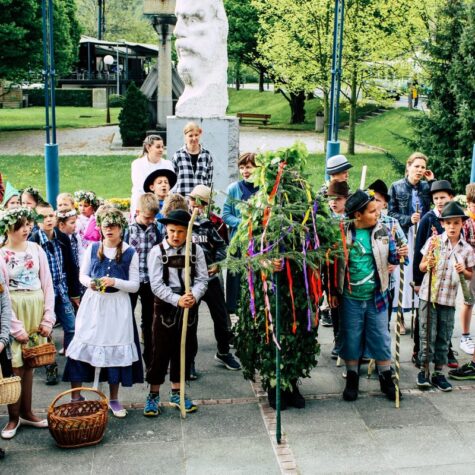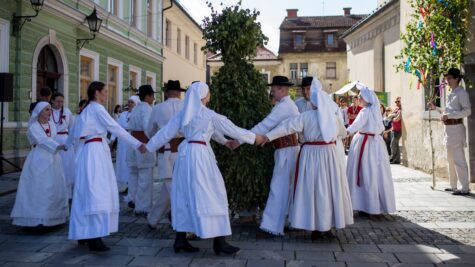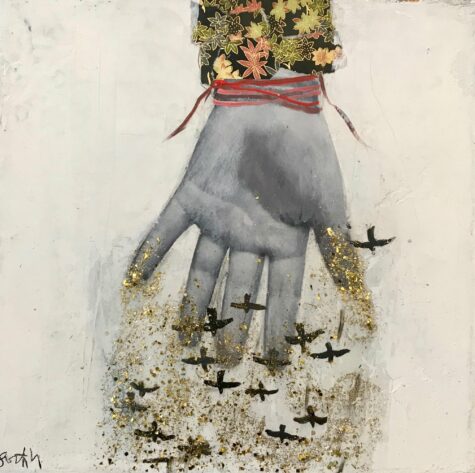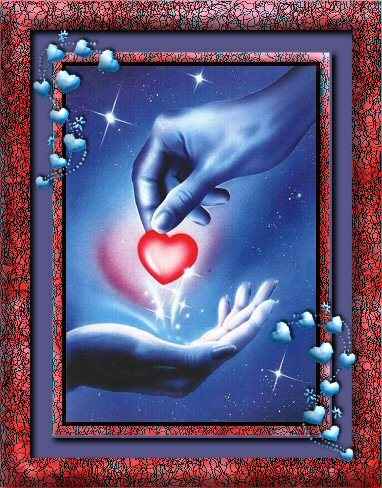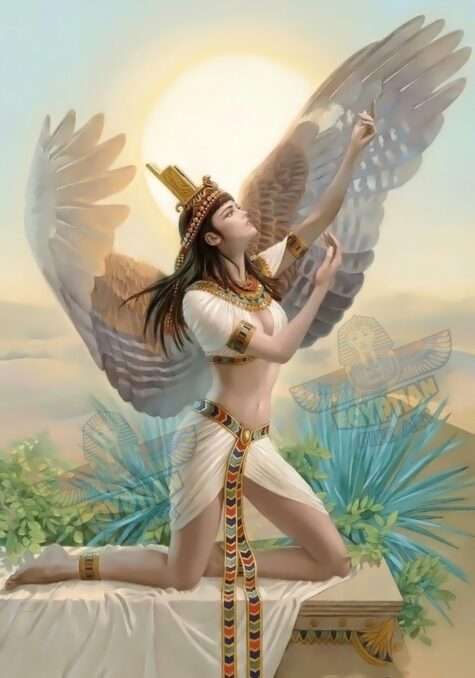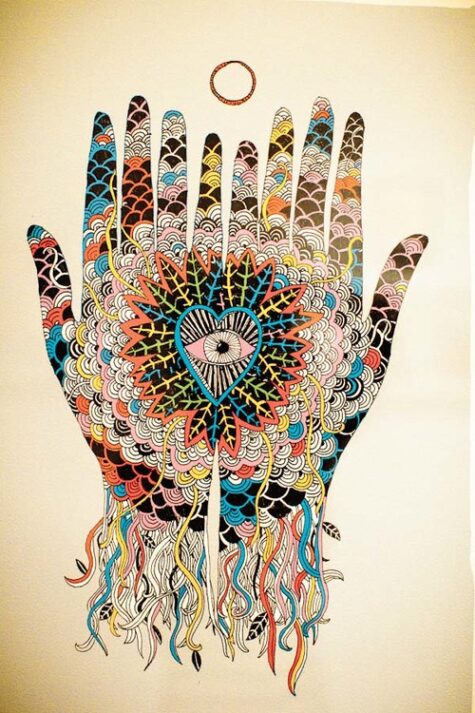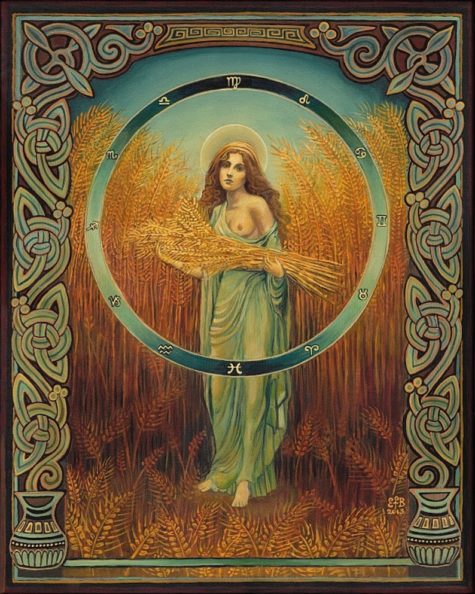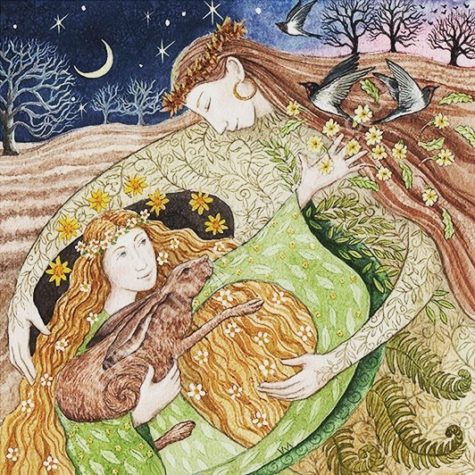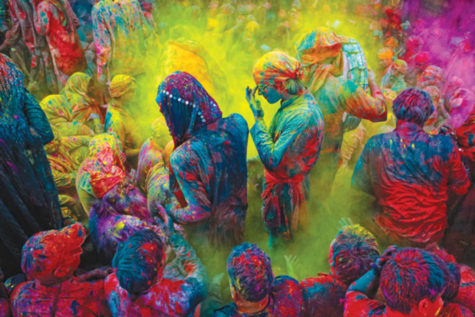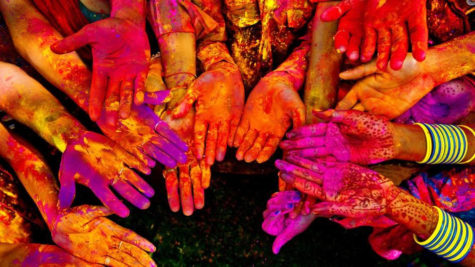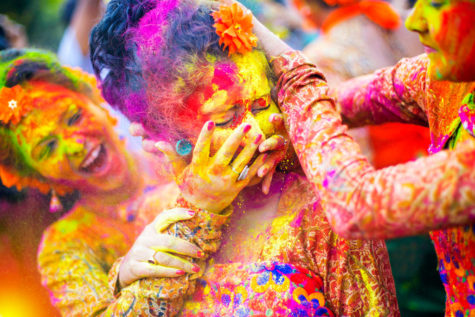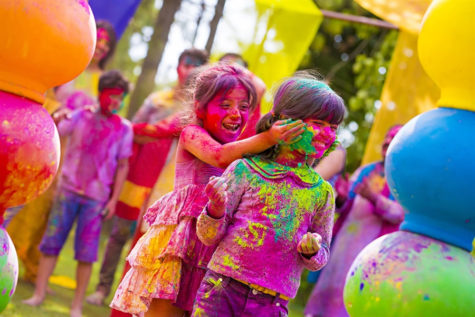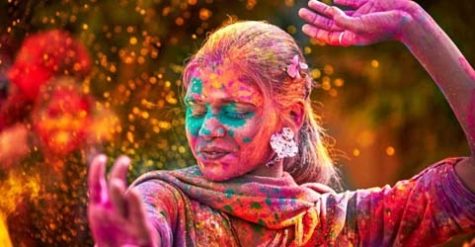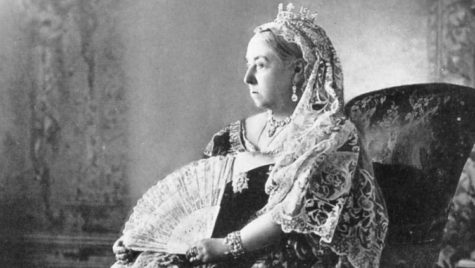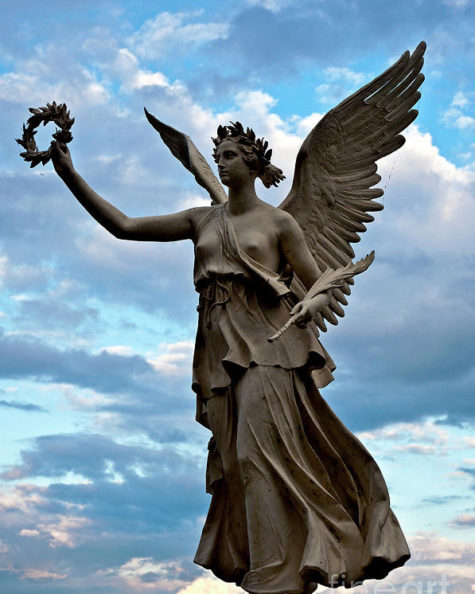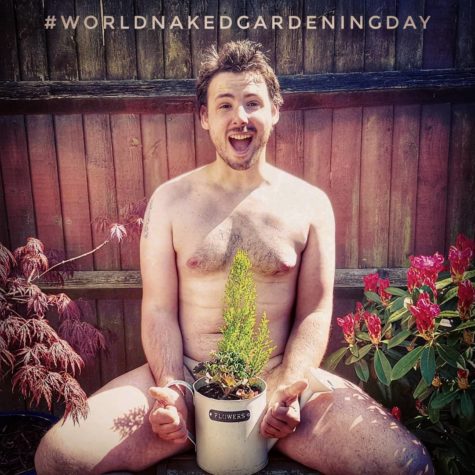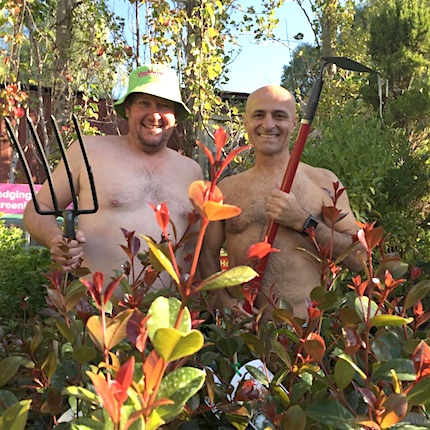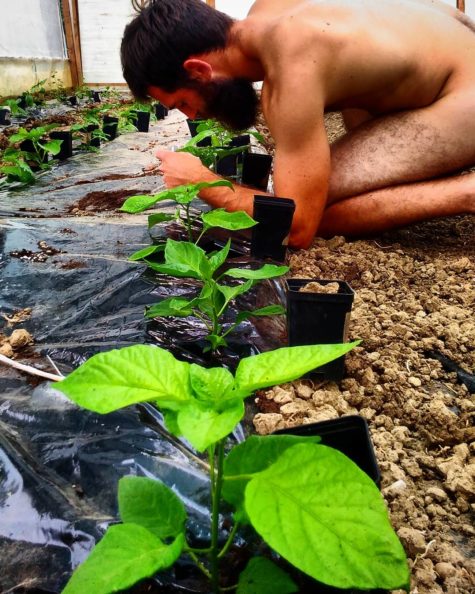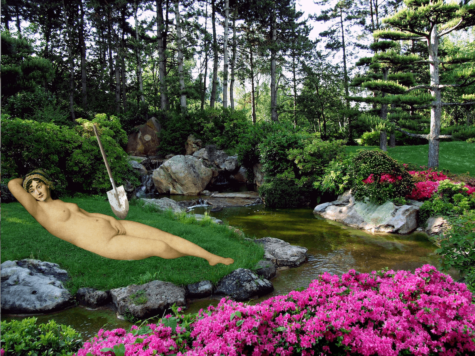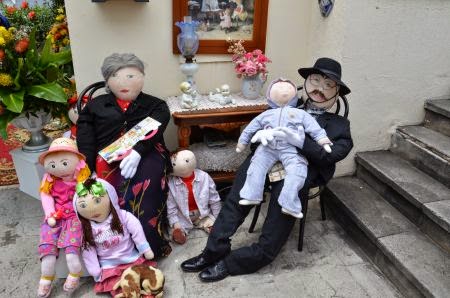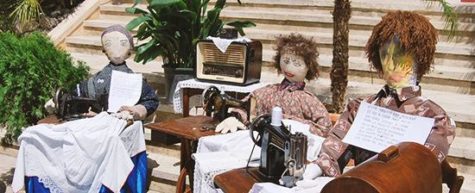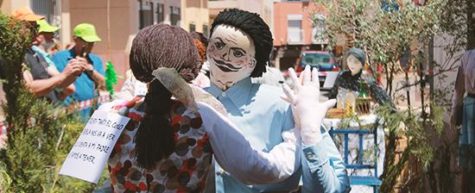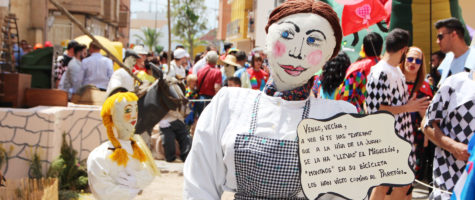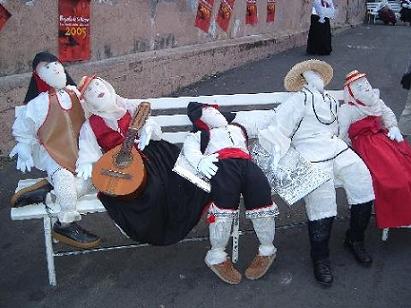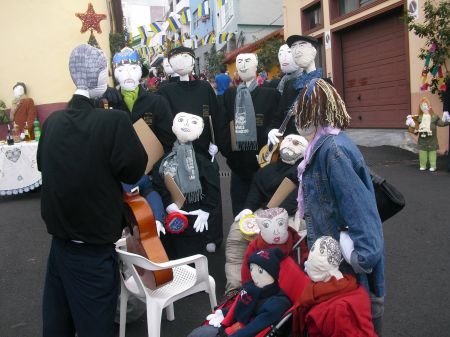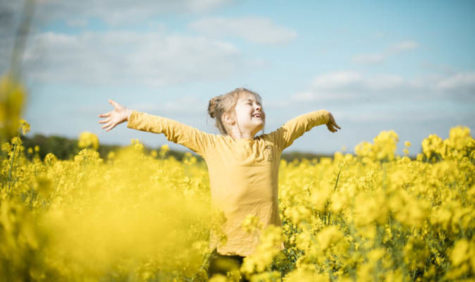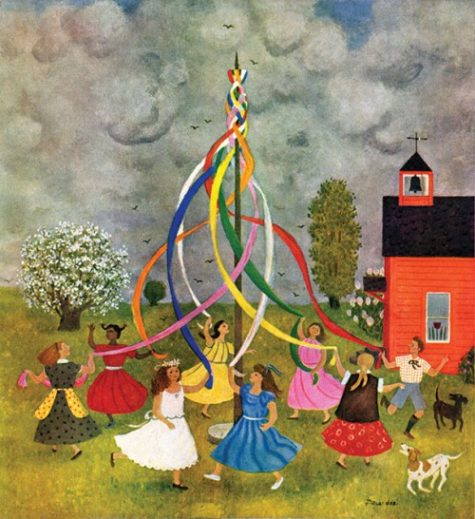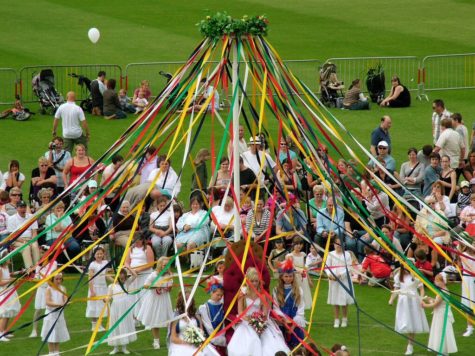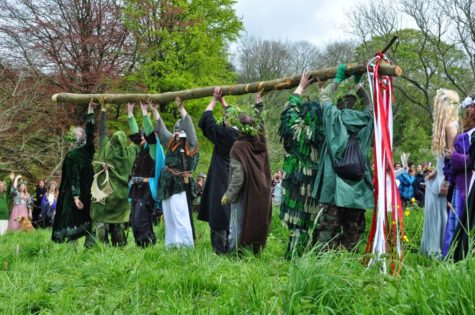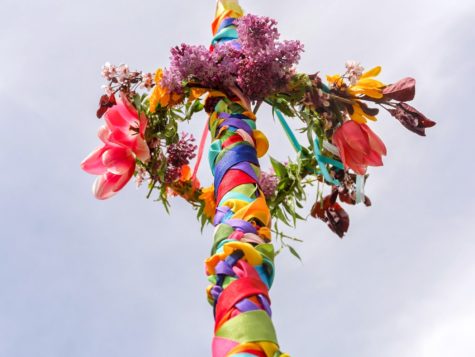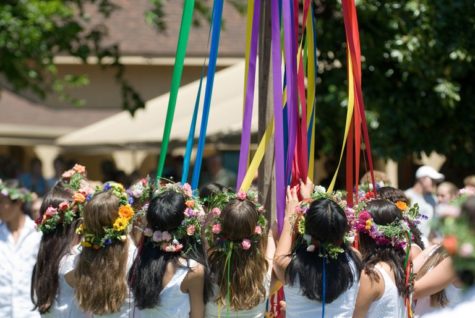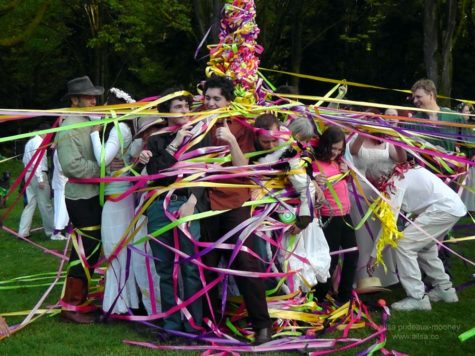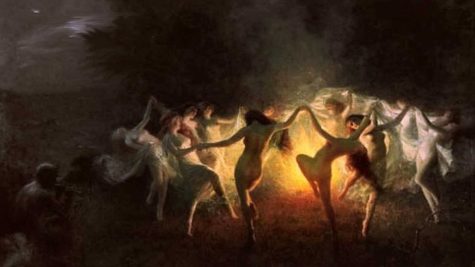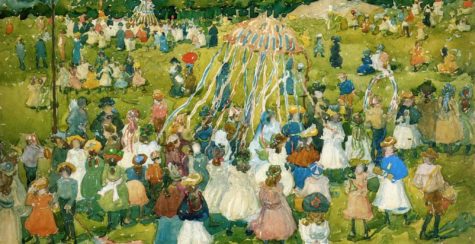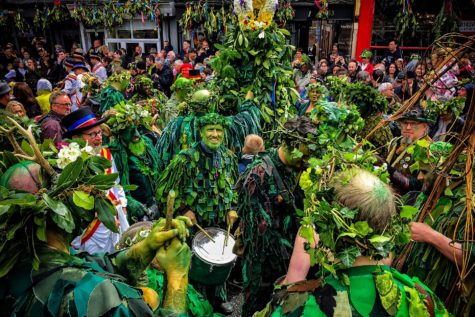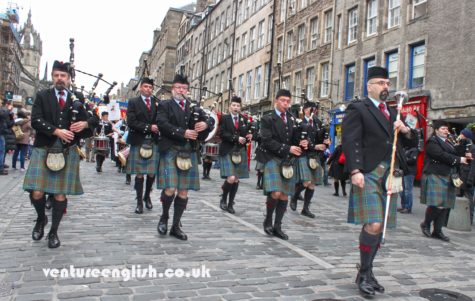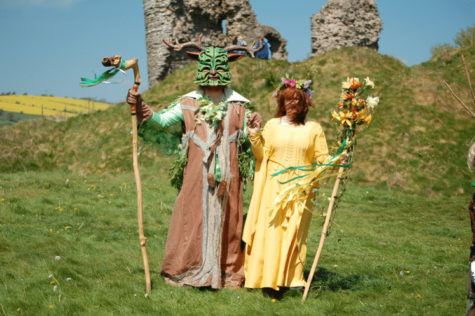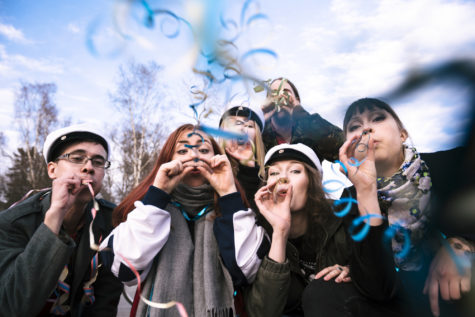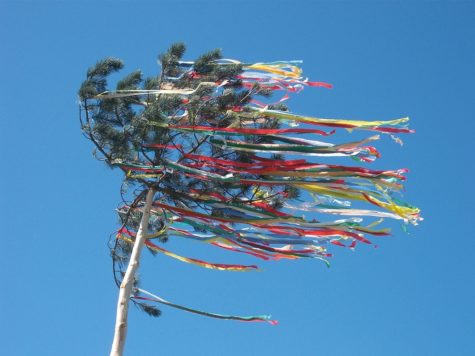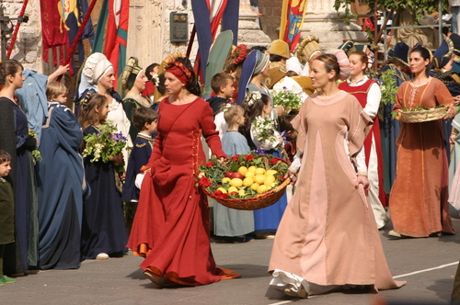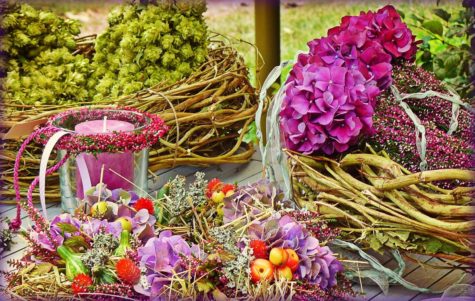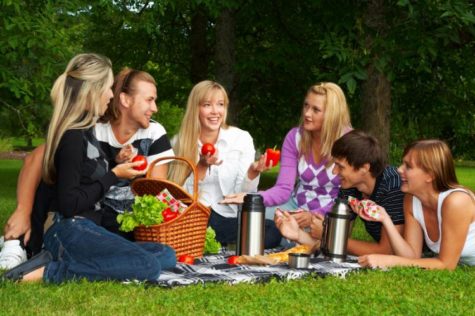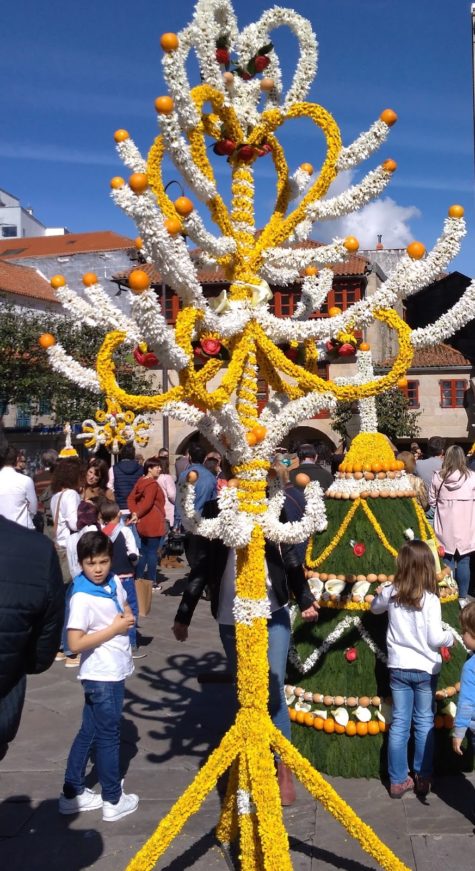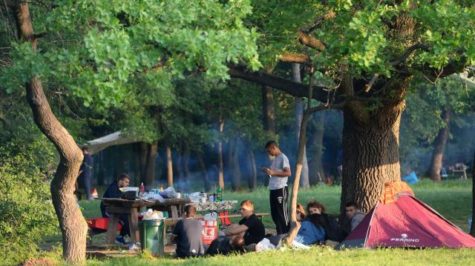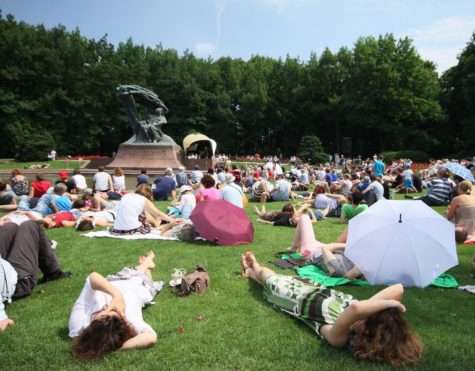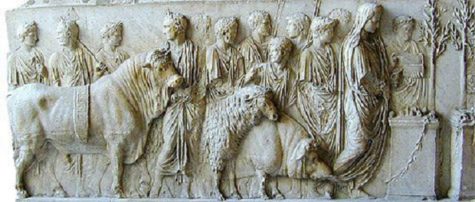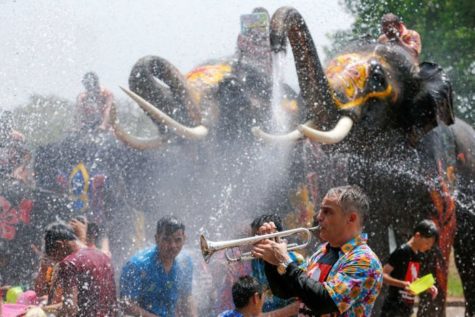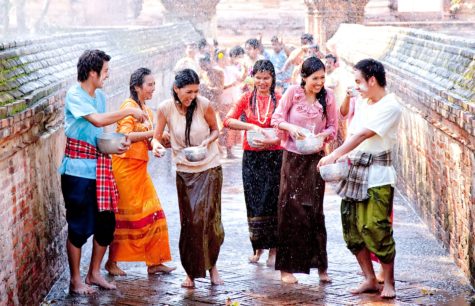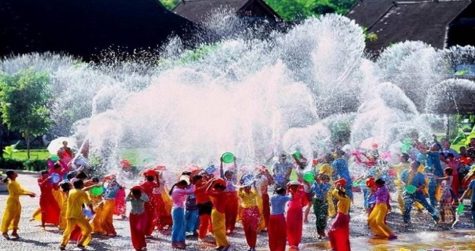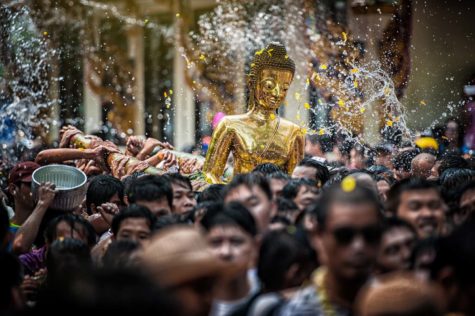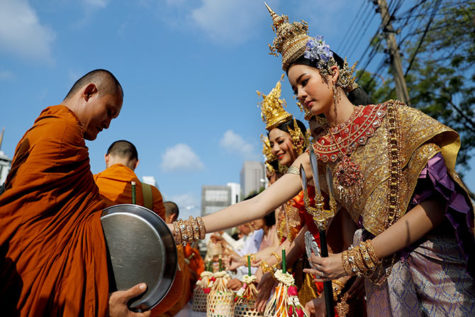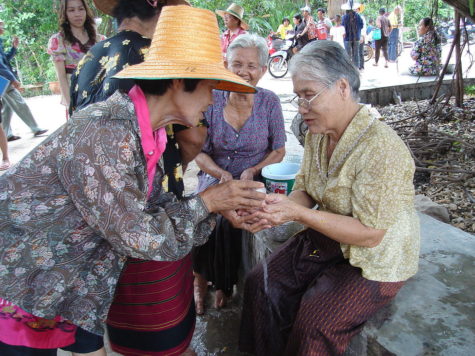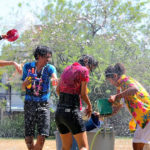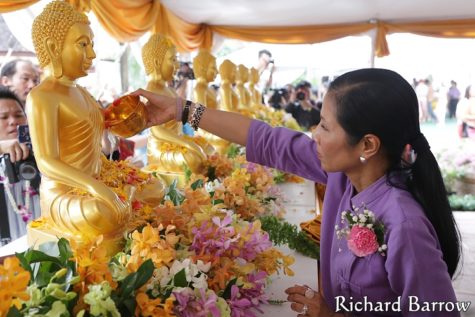Spring
Traditionally, on 23/24 April, in areas of Eastern Europe including Romania and Slovenia, people would celebrate ‘Green George’ (also known as ‘Zeleni Jurij’) where a young man would be covered in greenery, often birch and sometimes willow, to recognize the advent of spring and the springing of new life.
Celebrations would traditionally often center around a willow tree from which blessings, healings and protections were invoked.
In days gone by, Zeleni Jurij was celebrated differently in various parts of the region, but what the celebrations had in common was the persona of Zeleni Jurij himself: A young man covered entirely in birch branches, often additionally decorated with colored ribbons.
In some places, Zeleni Jurij went from house to house collecting money. Elsewhere, he rode to town on a white horse. In Črnomelj, Zeleni Jurij was paraded through the streets by singing young people who used ancient Slavic verses to interrogate this ancient harbinger of spring.
At the conclusion of the ceremony, Zeleni Jurij – or at least his arboreal covering – was ceremonially thrown into the Lahinja River.
Whatever the details, the celebrations served as an important rite of spring. According to tradition, Zeleni Jurij spent the winter in the cold, dark underworld, and emerged in the springtime to bring warmth and fertility to the land — and mark the final departure of winter.
Zeleni Jurij has its origins in Slavic mythology, but with the arrival of Christianity, the celebrations merged with the mythology of St. George, a Christian martyr also associated with fertility. The pagan-Christian blend was not unusual, since early Christian missionaries often accepted elements of pagan beliefs only to combine them with Christian teaching. It was due to this Christian influence that Zeleni Jurij was eventually celebrated on St. George’s Day in April.
Because of increased communication and changing rural lifestyles, Zeleni Jurij celebrations began to disappear in the modern area, and most were gone by the early 20th century. In recent years, however, local enthusiasts have made an effort to preserve this part of Slovenia’s national heritage.
Each spring, the Slovenian President formally receives Zeleni Jurij and his entourage of young people. And each June, the town of Črnomelj organizes a Zeleni Jurij procession, bringing to life a rite of spring largely unchanged since the time when the Slavs first arrived in modern-day Slovenia.
Source: Slovenia Revealed
This little-known festival was celebrated at the Temple of Edfu. It doesn’t sound like a Goddess festival, but it is, for the Hand of the God was called Iusaas or Iusaaset. This Goddess, honored in the city of Heliopolis wore a scarab beetle on her head, the symbol of transformation. She was the counterpart of the god Atum, literally his hand.
In the Pyramid Texts an early genesis story recounts how the divine All, the androgynous Atum, created the world from the substance of himself it reads:
“Atum was creative in that he proceeded to masturbate with himself in Heliopolis; he put his penis in his hand that he might obtain the pleasure of emission thereby, and there were born brother and sister ~ that is, Shu and Tefnut.”
Like Isis with whom she is sometimes identified, Iusaaset (whose name means “She Comes While She Grows Large,” a name underscoring the masturbation motif), had a sister called Nebet-hotepet, who is linked with Nephthys. Nephthys name probably means The House of Offering” perhaps referring to the womb of the All which is offered for use during the conception, gestation, and birth of the world.
It is no accident that the Feast of the Hand of the God occurs between two other birth festivals (The Birth of Horus the Younger and the Pregnancy of Nut). It is, after all, a season near the vernal equinox when light has returned to the sky and the days grow in length. It is a time when the world is made new again, when the Hand of the God brings forth life from the waters of chaos. It represents the union of masculine and feminine energies to create and sustain life.
Festival Celebration Ideas
It is unclear how the festival was celebrated in ancient Egypt. Some historians suggest that there might have been sexual rites or ritual marriages. This might be a good time for sex magick, if that is something that you enjoy.
In the Temple of Dendera, which has been called the Castle of the Menat, The Feast of the Hand of the God might have been a day in which all pregnant, including the wives and concubines of the pharaoh, might come to the temple to be blessed. Perhaps the day began with a sunrise devotion to the goddess as Mother of the All.
Perhaps amid the strains of beautiful music, the priestesses touched each pregnant woman’s belly and breasts, or anointed their faces with perfume, or even milk, whispering words of welcome to the unborn children, saying the same words priestesses used to great the nomarch Senbi, “for your spirit, behold the menat of your mother, Hathor. May she make you flourish as long as you desire.”
Hymn to Isis
Enchantress and wife, she stamps and spins.
She raises her arms
to dance. From her armpits arises a hot perfume
that fills the sails of boats along the Nile.
She stirs breezes that make the sailors swoon
and opens the eyes of statues. Under her spell,
I come to myself; under her body I come to life.
Dawn breaks through the diaphanous weave of
her dress. She dances and draws down heaven.
Sparks scatter from her heels and on earth tumbles
forth an expanse of stars…”
Activities For Today
Here are some ideas you might want to explore today. They can, of course, be done at any time.
- Get Creative
The act of creation can be playful, fun, colorful, and messy. Do a Google search and you will find a lot of simple ideas for how to make art with hand prints. This is a fun activity for kids, and the child within.
- Journaling
In your journal, explore what it means to you to be a cocreator of the universe with the Divine.
- Make a Collage
Gather some magazines that you feel free to cut up. Leaf through them, searching for images that appeal to you. Perhaps the images hint at where you focus your energies or where you will focus your energies in the future. Cut out the images and lay them aside. Outline your hands on a sheet of paper.
Slowly, meditatively, begin to trim, sort, and paste the images onto the image of your own hands. You might use the right hand for things that you already create and the left hand for things you will create in the future. Around the edges of these hands, write a myth of yourself as the creator of this world.
- Make a Physical Connection
Our bodies are instruments of our connection to the physical universe. Reestablish a connection to your body’s natural wisdom. With crayon, outline your body on a long sheet of butcher paper.
Begin at the top of your head and record what each part of your body remembers: your hair, your cheeks, your nose, etc. Try to list both joys and sorrows. When you find a part of your body that holds many strong memories, make not of it.
Later, return to that spot and write a dialog with that part of your body.
Source: Feasts of Light
Today (April 12) is the first day of the Ludi Cereales, another spring vegetation festival, this one in honor of the goddess Ceres, goddess of grains and cereal crops. It lasts for eight days, and like the Megalesia before it, the Cerealia culminates on its final day.
During Roman times, one of the symbolic rituals of the final day was the release of foxes into the Circus with flaming brands attached to their tails despite the fact that Ceres is notoriously a peaceful goddess and most often accepts offerings of spelt cakes and salt, as well as incense.
In the countryside, people offer milk, honey, and wine on the Cerealia (particularly the final day), after bearing them thrice around the fields.
More About This Festival
Ceres is the Goddess of agriculture, and was credited with the discovery of spelt wheat, the yoking of oxen and ploughing, the sowing, protection and nourishing of the young seed, and the gift of agriculture to humankind; before this, it was said, man had subsisted on acorns, and wandered without settlement or laws. She was the first to “break open the earth”, and all activities of the agricultural cycle were protected by her laws. She held the power to fertilize, multiply and fructify plant and animal seed, whose offspring were the physical incarnations of her power.
Her first plough-furrow opened the earth (Tellus’ realm) to the world of men and created the first field and its boundary; she thus determined the course of settled, lawful, civilized life. She mediated between plebeian and patrician factions. She oversaw the transition of women from girlhood to womanhood, from unmarried to married life and motherhood and the growth of children from infancy. Despite her chthonic connections to Tellus, she was not, according to Spaeth, an underworld deity. Rather, she maintained the boundaries between the realms of the living and the dead.
Given the appropriate rites, she would help the deceased into afterlife as an underworld shade (Di Manes): otherwise, the spirit of the deceased might remain among the living as a wandering, vengeful ghost.
The goddess was worshiped in many ways. There was the porca praecidanea, which involved sacrificing a fertile female pig and was necessary before a harvest. Cato indicates that sacrifices of any large food item will do, however, and suggests a pumpkin as an acceptable substitute for a pig, since it can be cut open and the seeds offered to Ceres in much the same way the entrails of the pig would be. After the offering of the porca praecidanea, it was customary to also give the goddess a libation of wine.
The poor could offer wheat, flowers, and a libation. The expectations of afterlife for initiates in the sacra Cereris may have been somewhat different, as they were offered “a method of living” and of “dying with better hope”.
Ceres’ major festival was the Cerealia – the ludi cereales, culminating on April 19 to celebrate the growth of grain and other agricultural products. Its original form is unknown; it may have been founded during the regal era. During the Republican era, it was organised by the plebeian aediles, and included ludi circenses (circus games). These opened with a horse race in the Circus Maximus, whose starting point lay just below the Aventine Temple of Ceres, Liber and Libera. In a nighttime ritual after the race, blazing torches were tied to the tails of live foxes, who were released into the Circus. The origin and purpose of this ritual are unknown; it may have been intended to cleanse the growing crops and protect them from disease and vermin, or to add warmth and vitality to their growth
Religiously, the purpose of the races and the games were to make the goddess favorably disposed toward the Roman people, so that she would give them a good harvest.
Visual depictions of Ceres were largely derived from Greek portrayals of Demeter. On two coin types, a bust of Ceres was pictured on one side, while a yoke of oxen was on the other. On other coins, she wears a crown of grain stalks called a corona spicea, holds stalks of wheat, and is occasionally pictured with wheat and barley grains. One coin actually portrayed her wearing a modius, an instrument used to measure grain, on her head. Another pictures a bust of series on one side, and a pair of seated male figures with a wheat stalk to their side on the other. The seated men represent the official distribution of grain to the people. Annona, the goddess who personified the wheat supply, appears alongside Ceres on several coins from the imperial period. Reliefs from the Augustan period have even gone so far as to depict her as a plant growing out of the ground. In one her bust emerges from the earth, holding bunches of poppies and grain in her upraised hands while two snakes twine about her arms.
Ceres also assimilated the visual symbols of the Eleusinian Mysteries, which most Romans observed in her name. Ceres is depicted with symbols of the Mysteries, such as riding in a chariot drawn by snakes while holding a torch in her right hand.
Persephone’s Return ~ A Ritual For The Cerelea
Most often celebrated on the last day of the Ludi Cereales (or April 19).
- Color: Green
- Element: Earth
- Offering: Flowers. Begin something new.
- Daily Meal: Dark, coarse bread. Root vegetables. Poppy seeds. Millet. Nuts and seeds.
Altar: Upon a green cloth set as many spring flowers as possible, a bowl of earth saved from the day of Persephone’s descent, and the figure of a girl’s head emerging from the earth.
Invocation to Persephone’s Return
Let the Earth take joy!
Demeter’s heart is warmed,
For her beloved daughter,
The maiden of Spring,
Has returned to the upper world!
Let all upon the Earth take joy!
Flowers spring from her footsteps,
Grass spreads between her toes,
The promise of the summer wind
Falls like butterflies newly loosed
From her hair the color of poppies and clay.
Let us all take joy!
She who descended in the autumn,
She who is married to Death
And yet arises in the bringing of Life,
She who has passed the bodies
Of a thousand corpses,
She who has sung with the shades
Of a thousand ancestors,
She rises to greet the morning sun
For as long as it is her time.
Then, like all things, she will descend again,
Into the depths of the Earth,
And we, we shall learn to love that cycle
Of rising and falling, of birth and death,
And truly call it a blessing.
Chant:
Kore Kore Kore Proserpina
Let one chosen for the work of the daily ritual carry the bowl of earth from person to person about the hall, and let each one take a bit of the earth and rub it on their faces, and let it remain until the evening ablutions.
~Info collected from various sources, including the Pagan Book of Hours
Holika, or Holi for short, is the Festival of Color. It marks the end of the nippy winter months and the beginning of spring. This festival comes during the full moon in the Hindu month of Phagan, in February or March. In 2019, it falls on March 21, with the Holika Dahan beginning the evening of March 20.
Bura na mano, Holi hai!
“Don’t mind (feel offense), it’s Holi!”
Holi is one of the major festivals of India and is celebrated on different dates every year. This great Indian festival is observed at the end of the winters in the month of March after the full Moon. A day before Holi a large bonfire is lit that helps in burning out the evil spirits and that whole process is called as Holika Dahan.
Traditions and customs:
- Throwing colored powder on each other
- Throwing colored and scented water
- Public bonfire
- Singing, dancing, and festive parties
- This is a day to forget your worries
- Color can be found everywhere
Holi is celebrated with extreme enthusiasm and joy. Gulal, abeer and pichkaris are synonymous with the festival. Elaborate plans are made to color loved ones and family members. Everybody wants to be the first one to color the other. In the ensuing battle of colors, everybody is drowned not just in colors of gulal but also in love and mirth. People love to drench each other in colored water. Gujiyas and other sweets are offered to everyone who comes across to color.
Temples are beautifully decorated at the time of Holi. Idol of Radha is placed on swings and devotees turn the swings singing devotional Holi songs. Small plays are organized reflecting the spirit of the festival.
Fun, frolic, boisterousness to the extent of buffoonery marks this festival of colors. What more can be expected- when the people get a social sanction to get intoxicated on the bhang, open not just their hearts but also their lungs. And viola, nobody is expected to take offense too, as the norm of the day is, ‘Bura na mano Holi hai‘.
Holi Legends and Mythology
Foremost is the legend of Prahlad and Hiranyakshyap. The legend says there once lived a devil and powerful king, Hiranyakshyap who considered himself a god and wanted everybody to worship him. He demanded that no one pray to Lord Vishnu and that they only pray to him. In fear, people did as he bid. However, his son Pralhad was devoted to Lord Vishnu and would not abide by his father’s rules. To discipline him, Hirankashyap ordered harsh and cruel punishments, yet no harm came to Pralhad.
Finally, Holika (Hirankashyap sister), who was immune to the harms of fire, was ordered to sit on a bed of flames with Pralhad on her lap. Holika was burnt, but Pralhad survived unharmed. As Holika lay dying she begged Pralhad for forgiveness. Pralhad forgave her and deemed that one day a year would be to remember her. To commemorate “Holi”, large bonfires burn and people say a prayer to “Holi” for well-being.
Holi is also associated with the immortal love of Krishna and Radha. A young Krishna complained to his mother Yashoda about having such a dark complexion compared to his love Radha who was so fair. Yashoda told him to apply color to Radha’s face and see what would happen.
Today, celebrations start early in Nandagaon, where Lord Krishna grew up. Men from Nandagaon raid nearby Barsana (where Radha grew up) with hopes of raising their flag over Shri Radhikaji’s temple. The women of Barsana “beat” the raiders with long wooden sticks. This is a mock battle and the men are well-padded as they try to evade capture. If captured, the men are forced to dress as women, paint their faces, and dance!
Mythology also states that Holi is the celebration of death of Ogress Pootana who tried to kill infant, Krishna by feeding him poisonous milk.
Another legend of Holi which is extremely popular in Southern India is that of Lord Shiva and Kaamadeva. According to the legend, people in south celebrate the sacrifice of Lord of Passion Kaamadeva who risked his life to revoke Lord Shiva from meditation and save the world.
Also, popular is the legend of Ogress Dhundhi who used to trouble children in the kingdom of Raghu and was ultimately chased away by the pranks of the children on the day of Holi. Showing their belief in the legend, children till date play pranks and hurl abuses at the time of Holika Dahan.
Cultural Significance
Celebration of the various legends associated with Holi reassure the people of the power of the truth as the moral of all these legends is the ultimate victory of good over evil. The legend of Hiranyakashyap and Prahlad also points to the fact that extreme devotion to god pays as god always takes his true devotee in his shelter.
All these legends help the people to follow a good conduct in their lives and believe in the virtue of being truthful. This is extremely important in the modern day society when so many people resort to evil practices for small gains and torture one who is honest. Holi helps the people to believe in the virtue of being truthful and honest and also to fight away the evil.
Besides, holi is celebrated at a time of the year when the fields are in full bloom and people are expecting a good harvest. This gives a people a good reason to rejoice, make merry and submerge themselves in the spirit of Holi.
Social Significance
Holi helps to bring the society together and strengthen the secular fabric of our country. For, the festival is celebrated by non-Hindus also as everybody like to be a part of such a colorful and joyous festival.
Also, the tradition of the Holi is that even the enemies turn friends on Holi and forget any feeling of hardship that may be present. Besides, on this day people do not differentiate between the rich and poor and everybody celebrate the festival together with a spirit of bonhomie and brotherhood.
In the evening people visit friends and relatives and exchange gifts, sweets and greetings. This helps in revitalizing relationships and strengthening emotional bonds between people.
Biological Significance
It is interesting to note that the festival of Holi is significant for our lives and body in many other ways than providing joy and fun.
We also need to thank our forefathers who started the trend of celebrating Holi at such a scientifically accurate time. And, also for incorporating so much fun in the festival.
Why Celebrate Holi?
As Holi comes at a time of the year when people have a tendency to feel sleepy and lazy. This is natural for the body to experiences some tardiness due to the change from the cold to the heat in the atmosphere. To counteract this tardiness of the body, people sing loudly or even speak loudly. Their movements are brisk and their music is loud. All of this helps to rejuvenate the system of the human body.
Besides, the colors when sprayed on the body have a great impact on it. Biologists believe the liquid dye or Abeer penetrates the body and enters into the pores. It has the effect of strengthening the ions in the body and adds health and beauty to it.
There is yet another scientific reason for celebrating the Holi, this however pertains to the tradition of Holika Dahan. The mutation period of winter and spring, induces the growth of bacteria in the atmosphere as well as in the body. When Holika is burnt, temperature rises to about 145 degrees Fahrenheit. Following the tradition when people perform Parikrima (circumambulation or going around) around the fire, the heat from the fire kills the bacteria in the body thus, cleansing it.
The way Holi is celebrated in south, the festival also promotes good health. For, the day after the burning of Holika people put ash (Vibhuti) on their forehead and they would mix Chandan (sandalpaste) with the young leaves and flowers of the Mango tree and consume it to promote good health.
Some also believe that play with colors help to promote good health as colors are said to have great impact on our body and our health. Western-Physicians and doctors believe that for a healthy body, colors too have an important place besides the other vital elements. Deficiency of a particular color in our body causes ailment, which can be cured only after supplementing the body with that particular color.
People also clean-up their houses on Holi which helps in clearing up the dust and mess in the house and get rid of mosquitoes and others pests. A clean house generally makes the residents feel good and generate positive energies.
Sources:
Victoria Day, also known as May Two-Four, May Long, and May Long Weekend, is a Canadian holiday on the Monday preceding May 25. (In 2019, this falls on May 20).
What Do People Do?
In some cities, fireworks displays or parades are held to mark Victoria Day. One of the most notable parades is held in the city of Victoria, British Columbia, which was named after Queen Victoria. Many people gather in parks to enjoy fireworks displays, which are particularly impressive in Hamilton and Toronto.
For many people, the long Victoria Day weekend marks the end of the winter and the unofficial start of the spring or summer season. After this weekend, gardeners can be reasonably sure that there will be no more frost until the autumn so they can sow or plant out delicate crops and plants.
For the same reason, people with recreational homes in colder parts of the country often go to them to open them up for the summer. In addition, many amusement parks and outdoor attractions open for their summer season this weekend. Notably, stores on Prince Edward Island are permitted to open on Sunday only between Victoria Day and Christmas Day.
The History of Victoria Day
Queen Victoria was born on May 24, 1819. Following the death of 3 uncles and her father, she became Queen of the United Kingdom on June 20, 1837 and reigned until her death on January 22, 1901. During Victoria’s life, the British Empire expanded considerably. However, her powers as Queen of the United Kingdom were reduced as the House of Commons became more important and powerful in British politics.
The monarch’s birthday has been celebrated in Canada since before the beginning of Queen Victoria’s reign. After her death, in 1901, May 25 became known as Empire Day. The sovereign’s official birthday was still celebrated, often on the King’s or Queen’s actual birthday. In 1952, Empire Day was moved to the Monday before May 25 and since 1953, the official birthday of Queen Elizabeth II has been celebrated on this date in Canada. In 1958, Empire Day became known as Commonwealth Day, which was moved to the second Monday in March. The Monday before May 25 then became known as Victoria Day, which is a Canadian statutory holiday.
From 365 Goddess
- Themes: Victory; Success; Excellence
- Symbols: Wings (or feathers); Laurel
- Presiding Goddess: Victoria
About Victoria:
Victoria, as her name implies is the Roman goddess of attainment. Early in the year she inspires resolve within us to do everything we undertake, with excellence as a goal. In works of art, Victoria is often depicted with wings that allow her to surmount any obstacle or problem.
To Do Today:
Drink a tea made from lemon balm, ginger, and a pinch of cinnamon to generate a successful attitude. Remember, if you think you can, you can!
Put a bay leaf (a form of laurel) in your shoe so that Victoria’s triumphant energy can walk with you all day long. Later in the day, burn a few bay leaves on a fire source to fill your home with success. Alternative aromas that invoke Victoria’s favor are rose and red sandalwood.
To make a victory charm, find a feather (or cut paper in the shape of a feather) and empower it with this incantation:
With the wings of Victoria, I will rise
above all areas where trouble lies
Through diligence and mastery I will see
today begins my victory!
Carry this token anytime you feel your confidence waning, or when you need a boost to get over any seemingly insurmountable obstacle.
Sources:
World Naked Gardening Day is an annual international event generally celebrated on the first Saturday of May by gardeners and non-gardeners alike. The best way to celebrate today is to have some fun getting naked outside with someone you love.
Yes, it’s true. Every person on the globe who loves both flowers and fig leaves will be tip-toeing through the tulips with nary a stitch on this Saturday. Why? Because planting a tuber in your birthday suit gives you an au naturel joie de vivre that can’t be matched any other way. As Barbara Pollard puts it, “When you’re out there with a gentle breeze on you, every last hair on your body feels it. You feel connected with the natural world in a way you just can’t in clothes.”
Now I know some of you are a little shy about appearing outdoors totally naked, but you shouldn’t be. For one thing, some of our most prominent political leaders are totally on board with it. For example:
Former President Barack Obama: “Once we discard the trappings of clothing, we see that people are just plain folks,” says the President. “We need to focus on things we have in common that bring folks together and gardening naked is one. Count me in.”
World Naked Gardening Day has no political agenda. Thus, it garnered widespread support from Democrats, Republicans, Libertarians, Tea Partiers, and Rush Limbaugh.
Kentucky Senator Mitch McConnell gave naked gardening the thumb’s up. “We’re all about horses in the Bluegrass State,” said Mitch, “and gardening naked makes me feel like a stud.”
Undress yourself of all that is superfluous, walk on the earth barefoot, touch the green leaves of the plants with your own hands and smell them; at least enjoy nature today in all its splendor, as it should really be experienced. Undress! You will feel free!
A Word of Caution
Whether with your friends or all alone, gardening naked has its risks. First of all, men should keep their distance from hedge trimmers, shears, pruners, saws, scythes, and even weed whackers.
Secondly, May marks the beginning of tick season in many areas of the world. So be sure someone spends at least 20 minutes giving you a thorough inspection following your naked day in the garden.
What To Plant
Although you’re free to plant anything you want on World Naked Gardening Day, some plants seem perfect fits. They include:
- ‘Buff Beauty’ rose
- Naked ladies (Lycoris squamigera)
- Fanny’s aster (Symphyotichum oblongifolium ‘Fanny’)
- Madonna lily (Lilium candidum), because Madonna is often naked.
- Led Zepplin’s Robert Plant totally naked… 🙂
What NOT to plant:
- Thorny plants and bushes.
- Cacti.
- Nettles or stinging plants and herbs.
About World Naked Gardening Day
The first annual World Naked Gardening Day took place on September 10, 2005. In 2007, the event date was moved to the first Saturday in May; as of 2018, the event still takes place on the first Saturday in May. In 2018, however, the New Zealand Naturist Federation adopted the last weekend in October as World Naked Gardening Day; this date was deemed to be better suited to the climate of the Southern Hemisphere.
According to NBC’s Today News, WNGD “has become an annual tradition that celebrates weeding, planting flowers and trimming hedges in the buff. While it’s linked to a movement of nudists who promote wholesome and unashamed acceptance of the human body, the day is meant to be funny, lighthearted and non-political, founders say.”
Organizers assert that “besides being liberating, nude gardening is second only to swimming as an activity that people are most ready to consider doing nude”.
Beyond body positivity, Corky Stanton of Clothes Free International, an organization that promotes nude recreation, has asserted that the event offers the “fringe benefits of bare, unabashed recreation: the satisfaction of exercising in the great outdoors; the attractiveness of an all-over tan; more Vitamin D on your whole body; the unbeatable experience of skinny-dipping if the naturist event involves a beach or a lake.”
While the event is most often celebrated in secluded areas, BFC first kicked off the event with its trademark “guerrilla pranksterism” and did a photo shoot in a public park. In another year, Storey and Gabriel enlisted the help of local free beach users at an unofficial clothing-optional beach park on Lake Washington, in Seattle. Many people choose not to venture beyond the relative safety of non-public areas. During the fifth annual World Naked Gardening Day in the United Kingdom, celebrated in 2010, organizers encouraged people to go naked either in their private gardens or in public parks.
Sources:
Los Mayos is a festival that takes place on the first Sunday in May in Alhama de Murcia. Although its origin is unknown and much earlier on, the first written references to it date from the 1920s. The festival consists of placing life-sized dolls dressed in old clothes with human features painted on their faces on doorsteps of houses in order to create a scene. They are normally dressed in clothes from old professions, representing everyday situations, or satirising certain modern-day problems.
The big dolls are made from fabric, stuffed with straw and painted with individual faces. They represent real people and they carry messages written on pieces of paper they either hold in their hands or have pinned to their clothes. They are a sort of caricature.
These dolls are placed over night at houses and public places, so the population awakes to a whole new set of ‘people’. The messages are funny, or express a wish or ridicule a certain attitude or quirk of someone. The dolls remain in place all day, are removed at night and displayed again elsewhere the next day.
Later they enter into a competition. But that’s not all. They also have the corremayos, musicians dressed in harlequin costumes who roam the streets all day, singing and making music, entertaining people.
Source:
May Day is a public holiday usually celebrated on 1 May. It is an ancient Northern Hemisphere spring festival and a traditional spring holiday in many cultures. Dances, singing, and cake are usually part of the festivities.
Ancient spring rites that related human fertility to crop fertility gave birth to most modern May Day festivities. May 1 is the traditional day to crown the May queen, dance around the maypole, perform mummers’ plays, and generally celebrate the return of spring. Although our Pilgrim fathers were horrified by these reminders of a pagan past and outlawed all such activities, the maypole dance remains an enduring event.
In Great Britain, the custom of “bringing in the May” involves gathering “knots,” or branches with buds, on the eve or early morning of May 1. In England, a favorite branch is hawthorn. In Scotland and Wales, people choose the rowan, or mountain ash. In North America, we often select forsythia, lilac, or pussy willow branches to bring spring and the prospect of new life into our homes.
The best known modern May Day traditions, observed both in Europe and North America, include dancing around the maypole and crowning the Queen of May. Fading in popularity since the late 20th century is the tradition of giving of “May baskets,” small baskets of sweets or flowers, usually left anonymously on neighbors’ doorsteps.
In the late 20th century, many neopagans began reconstructing some of the older pagan festivals and combining them with more recently developed European secular and Catholic traditions, and celebrating May Day as a pagan religious festival.
The Maypole
It’s impossible to think of Mayday without thinking of the Maypole. This is perhaps one of the most popular symbols of the season, representing the Divine Marriage between the Lord and Lady of the Greenwood. The pole represents the male principle, and the ribbons that wrap around it (and the wreath placed atop the pole) are symbolic of the female principle.
The Maypole represents the phallus of the God. The wreath atop represents the vagina of the Goddess. As the Maypole is danced, the ribbons wind around the pole and the wreath lowers, symbolizing the Divine Marriage, the sexual union of God and Goddess.
The Maypole Dance
The May Day dance is rich in pagan symbolism. There are usually eight dancers, one for each sabbat of the year, paired into four couples. (Of course, many more may dance. This is only a suggestion.) The dance involves moving in circles and weaving over and under the other dancers. The women take the white ribbons with their right sides to the pole, and the men take the red ribbons with their left sides to the pole.
The weaving of the symbolic birth canal begins with music or chanting as everyone moves forward from where they stand, moving alternately over and under each person coming toward them. (To start, the men begin weaving under the upheld ribbon of the first woman they encounter). Continue the dance until the maypole is wrapped. Tie off the ribbons and let the wreath drop to the ground.
Many folks wear bells when dancing the May dance. Make your steps a cross between a skip and a jog, coming down in time to the music, so that the bells mark off the beats of the music or chant.
May Day Chants
We are the flow and we are the ebb
We are the weavers, we are the web
We are the needle, we are the thread
We are the witches, back from the dead
Weavers, weavers,
We are weaving the web of life.
Weave, weave, weave me a rainbow
Out of the falling rain.
Weave me the hope of a new tomorrow.
Fill my cup again
Lady, weave Your circle tight
With a web of living light
Earth and Air and Fire and Water
Bind us to you.
The Pole
The traditional Maypole is a fir tree that has been stripped of all but its uppermost branches (often the trunk of the Yule tree was saved for the Maypole), but traditions vary. Some use oak; others pine. It may range in height from a few feet to as large as you care to make it. (Bear in mind, ribbon will need to be twice as long as the pole.) With unlimited space outdoors, ten feet is a good length. Of course, in a pinch, even a flagpole would do. For those who have restricted space or who have to celebrate indoors, a 3-4 foot dowel inserted in a wooden base and placed upon the altar will work as well.
If you cut a tree for the Maypole, please ask the tree’s permission before cutting and leave an offering at the base. An offering of food, wine, or flowers is entirely appropriate.
The Ribbons
However many ribbons you use, you will need equal numbers of at least two colors, depending on the number of dancers you’ll have. I recommend at least 6-8 dancers. Ribbons for the pole should be twice as long as the pole and about two to three inches wide. Colors vary according to preference. Traditional colors are red for the God and white for the virgin Goddess. Some use colors of the season — hunter green for the forest, gold for the sun, or purple for the color of grapes and wine. I’ve even heard of people using a rainbow of colors to represent the signs of the zodiac. Some traditions request that dancers bring a ribbon in a color representing a certain blessing they might wish for.
The ribbons can be tied just below the topmost branches of the tree or adhered to the top of the pole with thumbtacks, nails, or glue. In Dancing with the Sun, Yasmine Galenorn recommends making crosscuts on the top end of the pole, tying knots on the end of each ribbon, and threading the ribbons through the slits at the top of the pole. The knots will keep the ribbon from sliding out of the slits as it is woven around the pole.
The Wreath
The wreath should be made on Beltane morning. It is traditional to go to the fields to gather May flowers at this time. Fashion a wreath from greenery and decorate with the first blooms of the season. It must be somewhat bigger than the top of the maypole, taking into account any branches you left at the top, in order that it may fall down the pole as the ribbons are wound.
Consecrate the Maypole
Erection of the Maypole should be carried out with great fanfare. Once the tree has been selected, cut down, and the branches removed, it might be carried in processional to the dance site. Next, a hole must be dug. Pour an offering of water with a pinch of salt or a purifying herb like rosemary into the opening with words like:
Earth Mother, may this offering
Prepare you to receive
This symbol of your consort, our Lord.
Next, anoint the Maypole itself, using altar oil or a mixture of any of the following: myrrh, musk, and/or sweet woodruff. With the oil, make the sign of the solar cross, or the Rune inguz, a rune related to the annual “king’s circuit,” or walking of the land, to ensure the fertility of the land:
At each anointing, say:
Blessed be this tree,
Vehicle of our Lord
Which shall soon enter
Our Mother, the Earth.
When the Maypole has been erected and decorated, light the balefire and celebrate!
Historical May Day Celebrations
The earliest known May celebrations appeared with the Floralia, festival of Flora, the Roman goddess of flowers, held on 27 April during the Roman Republic era, and the Maiouma or Maiuma, a festival celebrating Dionysus and Aphrodite on an unknown date in May every three years. The Floralia opened with theatrical performances. In the Floralia, Ovid says that hares and goats were released as part of the festivities. Persius writes that crowds were pelted with vetches, beans, and lupins. A ritual called the Florifertum was performed on either April 27 or May 3, during which a bundle of wheat ears was carried into a shrine, though it is not clear if this devotion was made to Flora or Ceres. Floralia concluded with competitive events and spectacles, and a sacrifice to Flora.
According to the 6th century chronicles of John Malalas, the Maiouma was a “nocturnal dramatic festival, held every three years and known as Orgies, that is, the Mysteries of Dionysus and Aphrodite” and that it was “known as the Maioumas because it is celebrated in the month of May-Artemisios”. During this time, enough money was set aside by the government for torches, lights, and other expenses to cover a thirty-day festival of “all-night revels.” The Maiouma was celebrated with splendorous banquets and offerings. Its reputation for licentiousness caused it to be suppressed during the reign of Emperor Constantine, though a less debauched version of it was briefly restored during the reigns of Arcadius and Honorius, only to be suppressed again during the same period.
A later May festival celebrated in Germanic countries, Walpurgis Night, commemorates the official canonization of Saint Walpurga on May 1st, 870. In Gaelic culture, the evening of April 30th was the celebration of Beltane (which translates to “lucky fire”), the start of the summer season. First attested in 900 AD, the celebration mainly focused on the symbolic use of fire to bless cattle and other livestock as they were moved to summer pastures. This custom continued into the early 19th century, during which time cattle would be made to jump over fires to protect their milk from being stolen by fairies. People would also leap over the fires for luck.
May Day was abolished and its celebration banned by Puritan parliaments during the Interregnum, but reinstated with the restoration of Charles II in 1660. 1 May 1707, was the day the Act of Union came into effect, joining England and Scotland to form the Kingdom of Great Britain.
Queen Guinevere’s Maying, by John Collier
For thus it chanced one morn when all the court,
Green-suited, but with plumes that mocked the may,
Had been, their wont, a-maying and returned,
That Modred still in green, all ear and eye,
Climbed to the high top of the garden-wall
To spy some secret scandal if he might,
Since the 18th century, many Roman Catholics have observed May – and May Day – with various May devotions to the Blessed Virgin Mary. In works of art, school skits, and so forth, Mary’s head will often be adorned with flowers in a May crowning. 1 May is also one of two feast days of the Catholic patron saint of workers St Joseph the Worker, a carpenter, husband to Mother Mary, and surrogate father of Jesus. Replacing another feast to St. Joseph, this date was chosen by Pope Pius XII in 1955 as a counterpoint to the communist International Workers Day celebrations on May Day.
In the late 19th century, May Day was chosen as the date for International Workers’ Day by the Socialists and Communists of the Second International to commemorate the Haymarket affair in Chicago. International Workers’ Day can also be referred to as “May Day”, but it is a different celebration from the traditional May Day.
May Day Celebrations Around The World
- England
Traditional English May Day rites and celebrations include crowning a May Queen and celebrations involving a maypole, around which dancers often circle with ribbons. Historically, Morris dancing has been linked to May Day celebrations. The earliest records of maypole celebrations date to the 14th century, and by the 15th century the maypole tradition was well established in southern Britain.
In Oxford, it is a centuries-old tradition for May Morning revellers to gather below the Great Tower of Magdalen College at 6 am to listen to the college choir sing traditional madrigals as a conclusion to the previous night’s celebrations. Since the 1980s some people then jump off Magdalen Bridge into the River Cherwell. For some years, the bridge has been closed on 1 May to prevent people from jumping, as the water under the bridge is only 2 feet (61 cm) deep and jumping from the bridge has resulted in serious injury in the past. There are still people who climb the barriers and leap into the water, causing themselves injury.
In Durham, students of the University of Durham gather on Prebend’s Bridge to see the sunrise and enjoy festivities, folk music, dancing, madrigal singing and a barbecue breakfast. This is an emerging Durham tradition, with patchy observance since 2001.
Whitstable, Kent, hosts a good example of more traditional May Day festivities, where the Jack in the Green festival was revived in 1976 and continues to lead an annual procession of Morris dancers through the town on the May bank holiday.
A separate revival occurred in Hastings in 1983 and has become a major event in the town calendar. A traditional sweeps festival is performed over the May bank holiday in Rochester, Kent, where the Jack in the Green is woken at dawn on 1 May by Morris dancers.
At 7:15 p.m. on 1 May each year, the Kettle Bridge Clogs Morris dancing side dance across Barming Bridge (otherwise known as the Kettle Bridge), which spans the River Medway near Maidstone, to mark the official start of their Morris dancing season.
Also known as Ashtoria Day in northern parts of rural Cumbria. A celebration of unity and female bonding. Although not very well known, it is often cause for huge celebration.
Padstow in Cornwall holds its annual Obby-Oss (Hobby Horse) day of festivities. This is believed to be one of the oldest fertility rites in the UK; revellers dance with the Oss through the streets of the town and even through the private gardens of the citizens, accompanied by accordion players and followers dressed in white with red or blue sashes who sing the traditional “May Day” song. The whole town is decorated with springtime greenery, and every year thousands of onlookers attend. Prior to the 19th-century, distinctive May Day celebrations were widespread throughout west Cornwall, and are being revived in St. Ives and Penzance.
Kingsand, Cawsand and Millbrook in Cornwall celebrate Flower Boat Ritual on the May Day bank holiday. A model of the ship The Black Prince is covered in flowers and is taken in procession from the Quay at Millbrook to the beach at Cawsand where it is cast adrift. The houses in the villages are decorated with flowers and people traditionally wear red and white clothes. There are further celebrations in Cawsand Square with Morris dancing and May pole dancing.
- Scotland
May Day has been celebrated in Scotland for centuries. It was previously closely associated with the Beltane festival. Reference to this earlier celebration is found in poem ‘Peblis to the Play’, contained in the Maitland Manuscripts of fifteenth- and sixteenth-century Scots poetry:
At Beltane, quhen ilk bodie bownis
To Peblis to the Play,
To heir the singin and the soundis;
The solace, suth to say,
Be firth and forrest furth they found
Thay graythis tham full gay;
God wait that wald they do that stound,
For it was their feist day,
Thay said, […]
The poem describes the celebration in the town of Peebles in the Scottish Borders, which continues to stage a parade and pageant each year, including the annual ‘Common Riding’, which takes place in many towns throughout the Borders. As well as the crowning of a Beltane Queen each year, it is custom to sing ‘The Beltane Song’.
In Edinburgh, the Beltane Fire Festival is held on the evening of May eve and into the early hours of May Day on the city’s Calton Hill. An older Edinburgh tradition has it that young women who climb Arthur’s Seat and wash their faces in the morning dew will have lifelong beauty. At the University of St Andrews, some of the students gather on the beach late on April 30 and run into the North Sea at sunrise on May Day, occasionally naked. This is accompanied by torchlit processions and much elated celebration.
- Wales
In Wales the first day of May is known as Calan Mai or Calan Haf, and parallels the festival of Beltane and other May Day traditions in Europe.
Traditions would start the night before (Nos Galan Haf) with bonfires, and is considered a Ysbrydnos or spirit night when people would gather hawthorn and flowers to decorate their houses, celebrating new growth and fertility. While on May Day celebrations would include summer dancing and May carols other times referred to as “singing under the wall”, May Day was also a time for officially opening a village green.
- Finland
In Finland, Walpurgis night (Vappu) (“Vappen”) is one of the four biggest holidays along with Christmas Eve, New Year’s Eve, and Midsummer. Walpurgis witnesses the biggest carnival-style festival held in Finland’s cities and towns. The celebrations, which begin on the evening of 30 April and continue on 1 May, typically centre on the consumption of sima, sparkling wine and other alcoholic beverages.
Student traditions, particularly those of engineering students, are one of the main characteristics of Vappu. Since the end of the 19th century, this traditional upper-class feast has been appropriated by university students. Many university-preparatory high school alumni wear the black and white student cap and many higher education students wear student coveralls. One tradition is to drink sima, a home-made low-alcohol mead, along with freshly cooked funnel cakes.
- France
On 1 May 1561, King Charles IX of France received a lily of the valley as a lucky charm. He decided to offer a lily of the valley each year to the ladies of the court. At the beginning of the 20th century, it became custom to give a sprig of lily of the valley, a symbol of springtime, on 1 May. The government permits individuals and workers’ organisations to sell them tax-free on that single day. Nowadays, people may present loved ones either with bunches of lily of the valley or dog rose flowers.
- Germany
In rural regions of Germany, especially the Harz Mountains, Walpurgisnacht celebrations of pagan origin are traditionally held on the night before May Day, including bonfires and the wrapping of a Maibaum (maypole). Young people use this opportunity to party, while the day itself is used by many families to get some fresh air. Motto: “Tanz in den Mai” (“Dance into May”).
In the Rhineland, 1 May is also celebrated by the delivery of a maypole, a tree covered in streamers to the house of a girl the night before. The tree is typically from a love interest, though a tree wrapped only in white streamers is a sign of dislike. Women usually place roses or rice in the form of a heart at the house of their beloved one. It is common to stick the heart to a window or place it in front of the doormat. In leap years, it is the responsibility of the women to place the maypole. All the action is usually done secretly and it is an individual’s choice whether to give a hint of their identity or stay anonymous.
- Ireland
May Day has been celebrated in Ireland since pagan times as the feast of Beltane (Bealtaine) and in latter times as Mary’s day. Traditionally, bonfires were lit to mark the coming of summer and to grant luck to people and livestock. Officially Irish May Day holiday is the first Monday in May. Old traditions such as bonfires are no longer widely observed, though the practice still persists in some places across the country.
- Italy
In Italy it is called Calendimaggio or cantar maggio a seasonal feast held to celebrate the arrival of spring. The event takes its name from the period in which it takes place, that is, the beginning of May, from the Latin calenda maia. The Calendimaggio is a tradition still alive today in many regions of Italy as an allegory of the return to life and rebirth. This magical-propitiatory ritual is often performed during an almsgiving in which, in exchange for gifts (traditionally eggs, wine, food or sweets), the Maggi (or maggerini) sing auspicious verses to the inhabitants of the houses they visit.
Throughout the Italian peninsula these Il Maggio couplets are very diverse—most are love songs with a strong romantic theme, that young people sang to celebrate the arrival of spring. Symbols of spring revival are the trees (alder, golden rain) and flowers (violets, roses), mentioned in the verses of the songs, and with which the maggerini adorn themselves. In particular the plant alder, which grows along the rivers, is considered the symbol of life and that’s why it is often present in the ritual.
Calendimaggio can be historically noted in Tuscany as a mythical character who had a predominant role and met many of the attributes of the god Belenus. In Lucania, the Maggi have a clear auspicious character of pagan origin. In Syracuse, Sicily, the Albero della Cuccagna (cf. “Greasy pole”) is held during the month of May, a feast celebrated to commemorate the victory over the Athenians led by Nicias. However, Angelo de Gubernatis, in his work Mythology of Plants, believes that without doubt the festival was previous to that of said victory.
It is a celebration that dates back to ancient peoples, and is very integrated with the rhythms of nature, such as the Celts (celebrating Beltane), Etruscans and Ligures, in which the arrival of summer was of great importance.
- Greece
Maios (Latin Maius), the month of May, took its name from the goddess Maia (Gr Μαία, the nurse), a Greek and Roman goddess of fertility. The day of Maios (Modern Greek Πρωτομαγιά) celebrates the final victory of the summer against winter as the victory of life against death. The celebration is similar to an ancient ritual associated with another minor demi-god Adonis which also celebrated the revival of nature.
There is today some conflation with yet another tradition, the revival or marriage of Dionysus (the Greek God of theatre and wine-making). This event, however, was celebrated in ancient times not in May but in association with the Anthesteria, a festival held in February and dedicated to the goddess of agriculture Demeter and her daughter Persephone. Persephone emerged every year at the end of Winter from the Underworld. The Anthesteria was a festival of souls, plants and flowers, and Persephone’s coming to earth from Hades marked the rebirth of nature, a common theme in all these traditions.
What remains of the customs today, echoes these traditions of antiquity. A common, until recently, May Day custom involved the annual revival of a youth called Adonis, or alternatively of Dionysus, or of Maios (in Modern Greek Μαγιόπουλο, the Son of Maia). In a simple theatrical ritual, the significance of which has long been forgotten, a chorus of young girls sang a song over a youth lying on the ground, representing Adonis, Dionysus or Maios. At the end of the song, the youth rose up and a flower wreath was placed on his head.
The most common aspect of modern May Day celebrations is the preparation of a flower wreath from wild flowers, although as a result of urbanisation there is an increasing trend to buy wreaths from flower shops. The flowers are placed on the wreath against a background of green leaves and the wreath is hung either on the entrance to the family house/apartment or on a balcony. It remains there until midsummer night.
On that night, the flower wreaths are set alight in bonfires known as St John’s fires. Youths leap over the flames consuming the flower wreaths. This custom has also practically disappeared, like the theatrical revival of Adonis/Dionysus/Maios, as a result of rising urban traffic and with no alternative public grounds in most Greek city neighbourhoods, not to mention potential conflicts with demonstrating workers.
- Bulgaria
On May Day, Bulgarians celebrate Irminden (or Yeremiya, Eremiya, Irima, Zamski den). The holiday is associated with snakes and lizards and rituals are made in order to protect people from them. The name of the holiday comes from the prophet Jeremiah, but its origins are most probably pagan.
It is said that on the days of the Holy Forty or Annunciation snakes come out of their burrows, and on Irminden their king comes out. Old people believe that those working in the fields on this day will be bitten by a snake in summer.
In western Bulgaria people light fires, jump over them and make noises to scare snakes. Another custom is to prepare “podnici” (special clay pots made for baking bread).
This day is especially observed by pregnant women so that their offspring do not catch “yeremiya” — an illness due to evil powers.
- Romania
On May Day, the Romanians celebrate the arminden (or armindeni), the beginning of summer, symbolically tied with the protection of crops and farm animals. The name comes from Slavonic Jeremiinŭ dĭnĭ, meaning prophet Jeremiah’s day, but the celebration rites and habits of this day are apotropaic and pagan (possibly originating in the cult of the god Pan).
The day is also called ziua pelinului (“mugwort day”) or ziua bețivilor (“drunkards’ day”) and it is celebrated to ensure good wine in autumn and, for people and farm animals alike, good health and protection from the elements of nature (storms, hail, illness, pests). People would have parties in natural surroundings, with lăutari (fiddlers) for those who could afford it. Then it is customary to roast and eat lamb, along with new mutton cheese, and to drink mugwort-flavoured wine, or just red wine, to refresh the blood and get protection from diseases. On the way back, the men wear lilac or mugwort flowers on their hats.
Other rites include, in some areas of the country, people washing their faces with the morning dew (for good health) and adorning the gates for good luck and abundance with green branches or with birch saplings (for the houses with maiden girls). The entries to the animals’ shelters are also adorned with green branches. All branches are left in place until the wheat harvest when they are used in the fire which will bake the first bread from the new wheat.
On May Day eve, country women do not work in the field as well as in the house to avoid devastating storms and hail coming down on the village.
Arminden is also ziua boilor (oxen day) and thus the animals are not to be used for work, or else they could die or their owners could get ill.
It is said that the weather is always good on May Day to allow people to celebrate.
- Portugal
“Maias” is a superstition throughout Portugal, with special focus on the northern territories and rarely elsewhere. It may also be referred to by other names, including Dia das Bruxas (Witches’ day), O Burro (the Donkey, referring to an evil spirit) or the last of April, as the local traditions preserved to this day occur on that evening only.
People put the yellow flowers of Portuguese brooms, the bushes are known as giestas. The flowers of the bush are known as Maias, which are placed on doors or gates and every doorway of houses, windows, granaries, currently also cars, which the populace collect on the evening of the 30th of April when the Portuguese brooms are blooming, to defend those places from bad spirits, witches and the evil eye. The placement of the May flower or bush in the doorway must be done before midnight.
These festivities are a continuum of the “Os Maios” of Galiza. In ancient times, this was done while playing traditional night-music. In some places, children were dressed in these flowers and went from place to place begging for money or bread. On the 1st of May, people also used to sing “Cantigas de Maio”, traditional songs related to this day and the whole month of May.
- Serbia
“Prvomajski uranak” (Reveille on May 1st) is a folk tradition and feast that consists of the fact that on May 1, people go in the nature or even leave the day before and spend the night with a camp fire. Most of the time, a dish is cooked in a kettle or in a barbecue. Among Serbs this holiday is widespread. Almost every town in Serbia has its own traditional first-of-may excursion sites, and most often these are green areas outside the city.
- Poland
In Poland, there is a state holiday on 1 May. It is currently celebrated without a specific connotation, and as such it is May Day. However, due to historical connotations, most of the celebrations are focused around Labor Day festivities. It is customary for labor activists and left-wing political parties to organize parades in cities and towns across Poland on this day. The holiday is also commonly referred to as “Labour Day” (“Święto Pracy”).
- Czech Republic
In Czech Republic, May Day is traditionally considered as a holiday of love and May as a month of love. The celebrations of spring are held on April 30th when a maypole (“májka” in Czech) is lifted—a tradition possibly connected to Beltane, since bonfires are also lit on that day. The event is similar to German Walpurgisnacht. It’s public holiday on April 30th. On May 31st, the maypole is taken down in an event called Maypole Felling.
On 1 May, couples in love are kissing under a blooming tree. A cherry, an apple or a birch is most often considered a suitable tree.
- United States
May Day was also celebrated by some early European settlers of the American continent. In some parts of the United States, May baskets are made. These are small baskets usually filled with flowers or treats and left at someone’s doorstep. The giver rings the bell and runs away.
- Hawaii
In Hawaii, May Day is also known as Lei Day, and it is normally set aside as a day to celebrate island culture in general and the culture of the Native Hawaiians in particular. Invented by poet and local newspaper columnist Don Blanding, the first Lei Day was celebrated on 1 May 1927 in Honolulu. Leonard “Red” and Ruth Hawk composed “May Day Is Lei Day in Hawai’i,” the traditional holiday song.
Sources:
- Wikipedia
- Dancing with the Sun by Yasmine Galenorn
- The Sabbats by Edain McCoy
- Ancient Ways by Pauline Campanelli
- Earth Witchery
- Almanac.com
The festival of the Robigalia is celebrated to appease the God Robigus (or perhaps the Goddess Robigo; the gender of this deity, who originated as one of the numinae, is uncertain), who is the deity of wheat-rust, mildew, and blight.
It is an ancient festival of the agricultural calendar, and is celebrated by the Flamen Quirinalis. Both a red dog and sheep are sacrificed to Robigus, along with wine and incense; prayers are then spoken to protect the crops. There is some connection with the ascension of the star Sirius, but it is unclear.
Games (ludi) in the form of “major and minor” races were held. The Robigalia was one of several agricultural festivals in April to celebrate and vitalize the growing season, but the darker sacrificial elements of these occasions are also fraught with anxiety about crop failure and the dependence on divine favor to avert it.
Verminus, a God who protects cattle against worm disease, might also be honored on this day.
The Robigalia has been connected to the Christian feast of Rogation, which was concerned with purifying and blessing the parish and fields and which took the place of the Robigalia on April 25 of the Christian calendar.
Sources:
The Songkran Festival is a national holiday in Thailand. It marks the beginning of the Thai New Year. It is a traditional Buddhist festival, and it is usually celebrated between 13 and 16 April unless the dates are modified by an official government announcement. In 2019, the holiday will be observed 12–16 April as 13 April falls on a Saturday.
On the first day they will dress up in new clothes and visit the local temple to make merit and then to their grandparents’ house in order to receive blessings. Afterwards, the youngsters will be out on the street taking part in the world’s biggest water fight.
The word “Songkran” comes from the Sanskrit word saṃkrānti, literally “astrological passage”, meaning transformation or change. The term was borrowed from Makar Sankranti, the name of a Hindu harvest festival celebrated in India in January to mark the arrival of spring. It coincides with the rising of Aries on the astrological chart and with the New Year of many calendars of South and Southeast Asia, in keeping with the Buddhist/Hindu solar calendar.
In Thailand, New Year is now officially celebrated on 1 January, Songkran was the official New Year until 1888, when it was switched to a fixed date of 1 April. Then in 1940, this date was shifted to 1 January. The traditional Thai New Year Songkran was transformed into a national holiday.
The Songkran Festival is also known as the water festival. It celebrates water as a ritual of washing away negativity from the year before. People celebrating Songkran take part in a traditional pouring of water that symbolizes washing away back luck and sins from a person’s life. Some people add herbs to the ritual water, as well.
As April is the hottest month of the year, the celebration of water is relevant on many levels of the festival. However, Songkran is not always celebrated in the same traditional manner. In big cities, the country takes to the streets. Cities like Bangkok see a host of street parties and water fights.
The most famous street party in Bangkok is called Silom. This party takes place all along a street that is over 4 kilometres in length. It is a huge party in which thousands of people have water fights with water guns, balloons and any other vessels they can get their hands on. The street is also crowded with vendors selling water guns, toys, food and drinks.
As a national holiday, offices and banks are closed during the three-day period. Many people take this as an opportunity to go visit their families. In addition to traditional water rituals and street parties, there are other key activities that the Thai people participate in during this week. Many will take this time to attend their temple. Some may also participate in an annual spring cleaning of their homes.
It’s Not Just A Giant Water Fight
The Songkran celebration is rich with symbolic traditions. Mornings begin with merit-making. Visiting local temples and offering food to the Buddhist monks is commonly practiced. On this specific occasion, performing water pouring on Buddha statues and the young and elderly is a traditional ritual on this holiday. It represents purification and the washing away of one’s sins and bad luck. As a festival of unity, people who have moved away usually return home to their loved ones and elders. Paying reverence to ancestors is an important part of Songkran tradition.
On the first day of the Songkran Festival, people will offer alms to monks. Thai people do this to make merit which is a good way to start the new year. Another way of making merit during the Songkran Festival is by releasing fish and birds back into the wild.
On the second day of Songkran, many families rise early and take part in traditional Buddhist rituals. They give alms to Buddhist monks. They also take part in a ritual that is known as ‘Bathing the Buddha image.’ During this ritual, devout followers will pour water over the statues of Buddha in their home and at their local temple.
Many cities around Thailand will have Songkran Parades to mark the start of the festival. During Songkran there are also beauty contests to find the most beautiful Thai woman and also the most handsome Thai man. The winners will take part in the parade.
During Songkran, it is traditional for Thai people to return to their ancestral homes and to pour water on the hands of their elders. They will also do this to anyone older than themselves that have been important in their lives like a teacher or other relative.
People also pour rose scented water on Buddha images as part of the ceremony. At the temples they organize ceremonies where you can go and pour rose scented water onto Buddha images and onto the hands of monks.
Another traditional activity for Songkran is making sand pagodas. This is a competition joined by local families to make the most beautiful pagoda made of sand. The original idea was for people to bring sand back to the temple which they may have inadvertently carried away on the sole of their shoes.
The Festivities Around Thailand:
- Central Region
People in this region clean their houses when Songkran approaches. All dress up in colorful clothing or Thai dress. After offering food to the monks, people will offer a requiem to their ancestors. People make merit offerings such as giving sand to the temple for construction or repair. Other forms of merit include releasing birds and fish. Nowadays, people also release other kinds of animals such as buffaloes and cows. Phra Pradaeng hosts traditional Mon ceremonies.
- Southern Region
Southerners have three Songkran rules: Work as little as possible and avoid spending money; do not hurt other persons or animals; do not tell lies.
- Northern Region
On April 7, Baan Had Siew in Si Satchanalai District hosts the’Elephant Procession Ordination’ event with a colorful parade where men dressed in the traditional clothes are taken to the temples on elephants. In northern Thailand April 13 is celebrated with gunfire or firecrackers to repel bad luck. On the next day, people prepare food and useful things to offer to the monks at the temple. People have to go to temple to make merit and bathe Buddha’s statue and after that they pour water on the hands of elders and ask for their blessings.
- Eastern Region
The eastern region has activities similar to the other part of Thailand, but people in the east always make merit at the temple throughout all the days of the Songkran Festival and create the sand pagoda. Some people, after making merit at the temple, prepare food to be given to the elderly members of their family.
- In Bangkok
In Bangkok, the capital city of Thailand, the Khao San Road and Silom Road are the hubs for modern celebration of Songkran. The roads are closed for traffic, and posts equipped with water guns and buckets full of water. The party runs day and night.
Some tips to make the most of the Songkran Festival:
Modern Songkran is renowned for the massive water-fights that take place on the streets of the cities and towns around the country, often continuing for three days or more. While the origins of the festival are far more sedate (more on that later), today Songkran is a pretty boisterous affair.
This is a great time to visit Thailand, but it definitely pays to be prepared if you haven’t experienced it before. Here are some tips to get you through:
- You Will Get Wet
If there is one thing we can say with certainty about Songkran, it’s that you are going to get wet. Very wet. That is, of course, unless you want to lock yourself in your home or hotel room for three or four days. Bringing a sense of fun to the occasion and accepting the fact that you’re going to get soaked many, many times over makes Songkran an infinitely more enjoyable experience. If it all gets too much, find a quiet place to chill out and dry off before returning to the fray.
- You Are Fair Game
If you go out during Songkran, then you are fair game. Don’t complain if you are squirted in the face with a water pistol or someone rubs white powder on your face. Although it might not seem like it, they are actually taking part in a centuries old tradition of paying respect to their elders. Let them do it and smile. Resistance is useless.
- Dress Appropriately
Don’t wear your best clothes. If you are a woman, try not to dress provocatively – particularly spaghetti strap tops or white t-shirts that become revealing when wet. Thai people are traditionally conservative, but some young men will take advantage of Songkran to grope you. Many of them have been partying all night and are drunk.
- Keep Your Cool
Keep your cool at all times. Everyone is just having fun. Be prepared for the buckets of water which have been pre-chilled with ice. Also beware that people might come up to you from behind to smear white powder on your face. If they are polite they will ask first. But, you won’t see that happen often. Try not to move too much when they are doing it as you might end up with the paste in your eyes. However, that is inevitable the longer you stay out.
- Protect Your Electronics
While Songkran is packed with excellent photo opportunities, it is advisable to leave high-end cameras and other expensive electronic equipment at home. Street vendors sell handy waterproof pouches that will effectively protect your smartphone and your cash.
If you take your camera then make sure you also have a plastic bag. Better still, buy a camera that is waterproof. Last year, many people ended up with soggy mobile phones that stopped working. The mobile phone vendors do good business during Songkran repairing them.
- Protect Your Papers
By law you have to carry your passport at all times. However, during Songkran you are running the risk of your important documents getting wet. Make photocopies of your passport to take out with you and leave all important documents in the hotel safe. It is advisable not to carry anything that can be damaged by water with you.
- Equip Yourself
Street vendors sell an impressive arsenal of water guns, buckets and anything else that can be used to soak passers by. Your weapon of choice is up to you. It’s best wear light, comfortable clothes that protect you from the sun. And if you really want to make like a local, be sure to invest in one of the very loud floral shirts you will see on sale everywhere.
- If You Opt Out
If you don’t want to take part in the water fights then you will need to stock up for at least 3-4 days. Some expats go out to buy enough DVD movies and food to last them the holidays. If you do venture out, the chances are high that you will get soaked.
The shopping malls and movie theatres are all open during Songkran. So, you can use these places as a safe haven. However, getting to them safely might be a problem. If you have to use public transport, make sure you use an air-conditioned bus or meter taxi. If you use a normal bus with the windows down or a tuk tuk then you will get soaked. Skytrain and subway are safe havens. Skywalks are reasonably safe.
- Travel Concerns
If you are going out in your car, try to stick to the main roads. There is no point in washing your car before or during Songkran. Wherever you go, your car will get plastered with white paste. Make sure that you have topped up your windscreen wipers with plenty of water. You will use them often. Whatever, you do, don’t forget to LOCK all car doors. If you stop at traffic lights or in a traffic jam, they will try to open your doors.
Lot’s of people drink day and night during Songkran and this new year period in Thailand sees the most horrific crashes on the roads. Most deaths occur on the side roads and in the evening. On the main roads most accidents are caused by drunk driving and speeding. If you are driving take extra care. There are a lot of drunk drivers out on the roads during Songkran. Personally, I don’t like to drive too far during this period and if I do, I stick to the roads that I know near my home.
- Plan Ahead
If you are planning to travel shortly before, after or during Songkran be sure to book ahead. Traditionally, this is a time when many Thais travel to their hometowns to visit family, so flights and even trains and buses can get booked up well in advance. Accommodation in certain areas, such as Chiang Mai, may also fill up quickly around Songkran.
Don’t make the mistake of thinking that the waterfights are only on 13-15 April. This year this is up against the weekend and so some kids might also play on Saturday. In addition, some areas of Thailand have their Songkran celebrations a week later. For example, Pattaya, Bangsaen and Koh Chang. The last of the waterfights will take place in Phra Pradaeng District of Samut Prakan on 24 April 2016.
- Visit a Temple
While Songkran today resembles a massive water-fight, it wasn’t always like that. The more traditional ritual of splashing fragrant water on Buddha statues and on the palms of elders is still common today as a symbol of cleansing. Acknowledging the true spirit of Songkran by visiting a temple is a great way to escape the madness. If you are in Bangkok, check out some of the temples in the Rattanokosin area.
Songkran is not just about water fights. Do make an effort to see the more traditional side. Early in the morning Thai people will be going to the temples to make merit. They will also bathe the monks and Buddha images with rose scented water. In the afternoon, they will build sand pagodas in the temple grounds.
- A Final Thought
If you are in Thailand, then I hope you go out and have some fun! The temperature is above 35 degrees Celsius and this is a good way to cool down. However, if you are not in Thailand, then try visiting your local Thai temple. Many of them will be holding Songkran activities.
The Story of Songkran
Like many celebrations and festivals in Thailand, Songkran has its origins deeply rooted in myth and legend. With Songkran, the myth revolves around Nang Songkran, or the Seven Ladies of Songkran.
In Thailand, the Hindu god Brahma, the creator and four-faced god, was also known as Kabila Phrom. He enjoyed betting and one day met a seven year old boy prince named, Thammabal Kumara who was prodigious in learning, being able to recite scriptures in public. The boy was also reputed to be able to understand the language of the birds.
Kabila Phrom wanted to test the child’s knowledge so he descended to earth and presented three riddles to the boy. Should Thammabal answer the 3 riddles correctly, Kabila Phrom would offer him his head to the boy. However, if the boy failed to come up with answers within seven days, he would lose his own head to Kabila Phrom. The three riddles were as follows:
- 1. Where did a person’s aura exist in the morning?
- 2. Where was a person’s aura at noon?
- 3. Where did it appear at night?
For six days the boy agonized over the answers to the riddles, yet could not come up with them. One the the seventh day, whilst lying under palm trees, he heard a male and female eagle joyfully talking about how they would soon be able to feast on a boy’s dead body. Not knowing the boy was was able to hear, the two eagles revealed the answers to the riddles. Thammabal immediately went to Kabila Phrom and recited the answers,
“In the morning, a person’s aura appeared on his face, so he washed it. At noon, it was at his chest; so, he wore perfume there. And at night, his aura moved to his feet; that was why he bathed them”.
Kabila Phrom had lost the bet and so had to cut off his own head. Kabila Phrom’s head, however, held special powers. It was extremely hot, so if it should touch the ground, the earth would be engulfed in a firestorm, destroying all life; if it should be left in the air, there would be no rain, bringing about vast drought and if it should be dropped into the sea, the sea would dry up.
In order to save the world from these possible disasters, the god’s seven daughters, the Nang Songkran, placed their father’s head on a phan (tray) and carried it in procession around Mount Meru before placing it in a cave on Mount Kailash with many offerings. Thus, at the beginning of each year, Kabila Phrom’s daughters would take turns to bring out the god’s head and carry it in procession around Mount Meru, this celebration is known as Songkran.
The seven daughters represent the seven days of the week and all have their particular names and vehicles that they ride on. The one who carries Kabila Phrom’s head on Songkran Day is called Nang Songkran, Miss Songkran. Thus, in some locations, “Miss Songkran” is crowned, where contestants are clothed in traditional Thai dress.
Sources:
